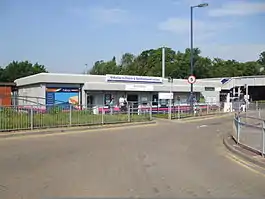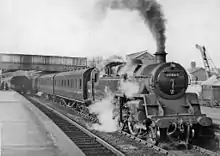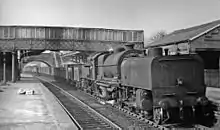Elstree & Borehamwood railway station
Elstree & Borehamwood railway station is a railway station in the town of Borehamwood, Hertfordshire, England. It primarily serves Borehamwood as well as the nearby village of Elstree, 1.3 miles (2.1 km) to the south-west.[3] The station is situated on the Midland Main Line, 12 miles 35 chains (20.0 km) down the line from London St Pancras and is situated between Mill Hill Broadway to the south and Radlett to the north. Its three-letter station code is ELS.
| Elstree & Borehamwood | |
|---|---|
 | |
 Elstree & Borehamwood Location of Elstree & Borehamwood in Hertfordshire | |
| Location | Borehamwood |
| Local authority | Borough of Hertsmere |
| Managed by | Thameslink |
| Station code | ELS |
| DfT category | E |
| Number of platforms | 4 |
| Accessible | Yes |
| Fare zone | 6 |
| National Rail annual entry and exit | |
| 2015–16 | |
| 2016–17 | |
| 2017–18 | |
| 2018–19 | |
| 2019–20 | |
| Key dates | |
| 13 July 1868 | Opened as "Elstree"[2] |
| 1 June 1869 | Renamed "Elstree and Boreham Wood"[2] |
| 1 April 1904 | Renamed "Elstree"[2] |
| 21 September 1953 | Renamed "Elstree and Borehamwood"[2] |
| 6 May 1974 | Renamed "Elstree"[2] |
| 5 May 1988 | Renamed "Elstree and Borehamwood"[2] |
| Other information | |
| External links | |
| WGS84 | 51.6531°N 0.2802°W |


Elstree & Borehamwood is also the first station down the line that is located outside the Greater London area; however, it is still within London's Travelcard zone area, and is located in Zone 6.
The station is served by Thameslink-operated trains on the Thameslink route.
History
In 1862:
- "The London and Midland Junction Railway Bill is here referred to as providing for a new line of Railway into the metropolis. It commences from the Midland Railway at Hitchin, passes by St. Albans, Elstree, Edgware, Finchley and Highgate, and terminates by a junction with the Metropolitan Underground Railway at King's Cross, previously throwing out a Branch to the Cattle Market at Copenhagen Fields."[4]
On 22 June 1863, the Midland Railway (Extension to London) Bill was passed:
- "An Act for the Construction by the Midland Railway Company of a new Line of Railway between London and Bedford, with Branches therefrom; and for other Purpose".[5]
Situated north of the Elstree Tunnels, it was built by the Midland Railway as simply "Elstree" in 1868 when it built its extension to St Pancras station. By the 1920s, it had been renamed Elstree and Boreham Wood station.[6] It was modernised in 1959.[7] The station was renamed from Elstree & Borehamwood to Elstree on 6 May 1974,[8] but reverted to Elstree & Borehamwood by mid 1988.
A new footbridge and step-free lifts, installed under Network Rail's Access for All programme, opened on 1 October 2014 in order to make Elstree & Borehamwood entirely step-free.[9]
The "London LOOP" walk passes close to the station on its way from Stanmore to High Barnet.
The station is a PlusBus destination where buses can be used from the station to the surrounding area by requesting a ticket to "Elstree & Borehamwood Plus Bus"
Services
The typical off-peak service from the station is six trains per hour (tph) southbound to London Blackfriars, of which:
- 2tph continue to Sutton via Mitcham Junction
- 2tph continue to Sutton via Wimbledon
- 2tph continue to Rainham via London Bridge (Monday to Friday only)
Northbound there are six trains per hour to St Albans, two of which continue to Luton. On Sundays this is reduced to two trains per hour before midday, but upped to four trains per hour afterwards, two of which continue to Luton.
Some evening services are extended to Bedford. Night services operate to Gatwick Airport, Three Bridges and Brighton.
East Midlands Railway InterCity services from Leeds, Sheffield, Leicester and Nottingham run through at high speed, but do not stop. Interchange with InterCity services can be made at Luton Airport Parkway or Luton and St Pancras International.
| Preceding station | Following station | |||
|---|---|---|---|---|
| Radlett | Thameslink Thameslink |
Mill Hill Broadway | ||
See also
- Elstree South tube station - unbuilt London Underground station
References
- "Station usage estimates". Rail statistics. Office of Rail Regulation. Please note: Some methodology may vary year on year.
- Butt, R. V. J. (1995). The Directory of Railway Stations: details every public and private passenger station, halt, platform and stopping place, past and present (1st ed.). Sparkford: Patrick Stephens Ltd. p. 91. ISBN 978-1-85260-508-7. OCLC 60251199.
- Yonge, John (March 2005) [1990]. Jacobs, Gerald (ed.). Railway Track Diagrams 4: Midlands & North West (2nd ed.). Bradford on Avon: Trackmaps. map 2A. ISBN 0-9549866-0-1.
- "Railway in the metropolis and suburbs", Accounts and papers of the House of Commons, Publ. House of Commons, 1862 (page 22)
- "Local and Personal Acts", The Sessional Papers Printed by Order of The House of the Lords Or Presented by Royal Command in the Session 1863, Published 1863 (page 119)
- The municipal year book of the United Kingdom, Publisher Municipal Journal., 1927. (page 438)
- Radford, B., (1983)Midland Line Memories: a Pictorial History of the Midland Railway Main Line Between London (St Pancras) & Derby London: Bloomsbury Books
- Slater, J.N., ed. (July 1974). "Notes and News: Stations renamed by LMR". The Railway Magazine. Vol. 120 no. 879. London: IPC Transport Press Ltd. p. 363. ISSN 0033-8923.
- http://www.borehamwoodtimes.co.uk/news/11493243.Railway_station_lifts_due_to_open_next_Wednesday/
External links
- Train times and station information for Elstree & Borehamwood railway station from National Rail
- grid reference TQ190962
Gallery
| Wikimedia Commons has media related to Elstree and Borehamwood railway station. |
 Slow platform 1 looking south
Slow platform 1 looking south Slow platform 1 looking north
Slow platform 1 looking north Fast platform 3 looking south
Fast platform 3 looking south Fast platform 3 looking north
Fast platform 3 looking north Platform signage
Platform signage Main building on Platform 1, with a snack bar in the foreground
Main building on Platform 1, with a snack bar in the foreground